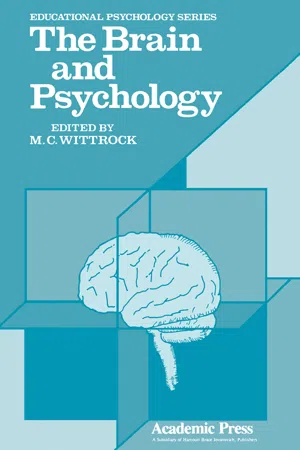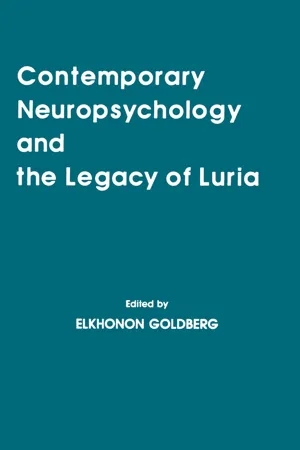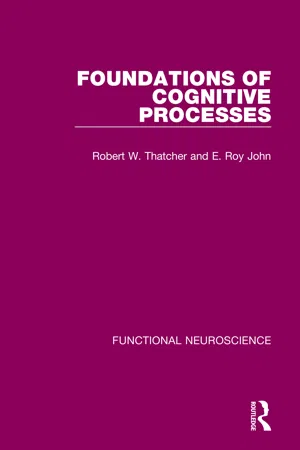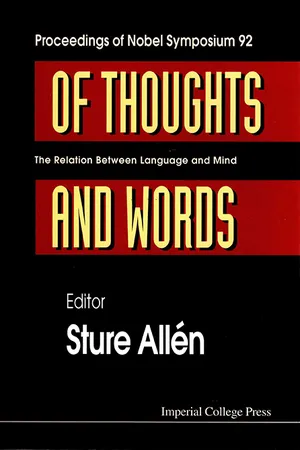Psychology
Localisation of Brain Function
The concept of "localisation of brain function" refers to the idea that specific mental functions are associated with particular areas of the brain. This concept suggests that different regions of the brain are responsible for different psychological processes, such as language, memory, and emotion. Research in this area has provided valuable insights into understanding how the brain supports various cognitive and emotional functions.
Written by Perlego with AI-assistance
Related key terms
1 of 5
11 Key excerpts on "Localisation of Brain Function"
- Anton Yasnitsky, René van der Veer, Michel Ferrari(Authors)
- 2014(Publication Date)
- Cambridge University Press(Publisher)
In the case of language, for instance, one localization is responsible for articulating speech and another localization for understanding speech. The lan- guage function depends on functioning of such localizations and brain structures that connect them. Third, there is also another principle that is less acknowledged: namely, localization of functions is not fixed. Persons with early brain damage to the left hemisphere, for instance, may rely on right hemispheric localizations in 326 aaro toomela language functions; the same right hemispheric localizations are not involved, and will not be involved even after the recovery period, if the damage occurs in an adult. Vygotsky, who formulated the principles that underlie cultural-historical neuro- psychology, also proposed that “every specific function is never connected to the activity of any one center, but always is a product of integrative activity of strictly differentiated and hierarchically connected one to another centers” (Vygotsky, 1982b, p. 170). Vygotsky went further with the principles underlying localiza- tion of the functions. He suggested, next, that mind should be understood as a whole. Therefore the relationship between localized brain damage and cognitive dysfunction is complex: (1) In case of any localized brain damage (aphasia, agnosia, apraxia), all other functions, which are not directly related to the damaged region, will suffer in a specific way and there is never uniform decrease of the functioning . . . (2) One and the same function, not related to the damaged region, will also suffer in an absolutely peculiar, absolutely specific way in case of different localizations of the damage and does not reveal the same focus in case of different localizations.- eBook - PDF
Language Communication and the Brain
A Neuropsychological Study
- Mariusz Maruszewski, Grace W. Shugar(Authors)
- 2017(Publication Date)
- De Gruyter Mouton(Publisher)
Although with some simplification, the localization issue can be reduced to two opposing theories, one postulating localization and the other denying this idea. The former conception posits a brain that is functionally differentiated, or composed of structures that serve different roles in controlling the activities of the organism. In the original narrow version (the psychomorphological conception), it was contended that, for every function of the organism, there is a corresponding distinctive centre, or organ, in the brain. Present-day proponents of the localization theory reject the existence of such centres; their more moderate views stress only that particular brain structures perform separate and distinct physiological functions necessary for the normal course of the organism's many different activities. Functionally differen-tiated, these structures interact dynamically to ensure each such activity. In its contem-porary version this conception is labelled the dynamic theory of functional localiza-tion. 1. EARLY OBSERVATIONS OF SPEECH DISORDERS FOLLOWING CEREBRAL DAMAGE 19 The opposing theory of anti-localization, in its most extreme version, denies any localization whatsoever as to the higher functions of the organism. The cerebrum is viewed as an undifferentiated and equipotential structure in respect to function. Higher functioning is the outcome of the activity of the entire brain tissue. It then follows that the search for centres, or structures with more or less fixed functions, is foredoomed to failure. It is clear that acceptance of one or the other of these positions has crucial signifi-cance for the problem we are tackling; each entails radically different consequences in any undertaking to elucidate the cerebral mechanisms of speech. Let us repeat that this controversy has had a determining effect upon both the historical growth of knowledge and the present state of thinking in this domain. - eBook - ePub
Cognitive Science
Contributions to Educational Practice
- Marlin L. Languis, James Buffer, Daniel Martin, Paul Naour(Authors)
- 2012(Publication Date)
- Taylor & Francis(Publisher)
Concepts about the relationship between brain and behavior have historically fallen into one of two diametrically opposed perspectives. The “localizers” represented by the tradition of Broca (1861) and others (Penfield & Boldrey, 1937; Benson & Geschwind, 1971) have conceived of behavioral localization as a mosaic of foci in the brain, with each foci representing discretely localized functions. This view was based on clinical-pathological correlations in which an important contribution to normal function is inferred from loss of behavior in pathological states (Wernicke, 1908) as well as the behavioral manifestations following electrical stimulation of intact tissue (Penfield & Boldrey). This idea of behavior as distributed in a “map” or “mosaic” fashion across the cortex has been a very powerful concept and has led to a basic understanding of the organization of language and motor-sensory function.The second concept of behavioral localization, termed “mass action”, was promoted by Lashley (1929). This concept emphasizes the behavioral importance of the amount of brain tissue lost. That is, the behavioral manifestations depend less on where tissue is lost in the brain than on how much tissue is lost. Chapman and Wolfe (1959) demonstrated that the deficits in cognition following neurosurgery correlated with the amount rather than the specific locus of brain tissue surgically removed. This is a powerful concept in brain injury that explains such clinical phenomena as the recovery from behavioral symptoms. In addition, this theory of mass action is more consistent with what we know about behavioral plasticity in the brain and recovery of function than the strict localizationist theory.Neither of these theories, however, has been able to explain the relationship between brain injury and emotional state. Localization of MoodNumerous investigators have studied relative hemispheric involvement in mood using brain-injured patients, intracarotid amytal injections, or unilateral visual or auditory input in nonbrain-injured volunteers. In a previous publication, we extensively reviewed this literature (Pearlson & Robinson, 1981). In general, these studies have commonly reported right-left hemisphere asymmetries in the production or expression of mood. For example, Gainotti (1972, 1979) has reported that right hemisphere brain injury is associated with indifference and a tendency to joke and minimize difficulties. Amytal studies have generally reported depressive reactions associated with left hemisphere inactivation and euphoria associated with right hemisphere inactivation (Terzian, 1964; Rossi & Rosandini, 1967). Likewise, tachistoscopic unilateral visual field stimulation and dichotic listening studies have reported negative emotion associated with right hemispheric stimulation and positive emotion following left hemisphere stimulation (Dimond, Farrington, & Johnson, 1976; Safer & Leventhal, 1977). Although there are numerous theories ranging from differential activation in the two hemispheres to each hemisphere producing a different mood (Tucker, 1981; Sackheim et al. - eBook - PDF
- M. C. Wittrock(Author)
- 2013(Publication Date)
- Academic Press(Publisher)
The more limited the individual's resource of attention (i.e., the shorter the cerebral functional distances that characterize his brain), the more important it is to be automatized, as much as possible, so that the attentional resources will be maximally available for unpredictable happenings. VIII. Why Function is Localized in the Drain We can now understand the need for localization of function in the brain. We will distinguish between vegetative and basic functions, such MARCEL KINSBOURNE 000 as the control of respiration, blood pressure, and pulse rate, and those cognitive functions with which we are chiefly concerned. The first type of function is adequately served by a precisely engineered and genet-ically predetermined neuronal arrangement. The less it is influenced by whatever else is happening in the brain, the better; although as is well known to psychophysiologists, even the simplest such functions are by no means invulnerable to the effects of changing brain states during higher mental functioning, as well as during variation in emo-tional states. When we consider the much more highly linked organiza-tion of the association areas of the cerebral cortex and the much more complex demands on it for variously patterned activation, it becomes clear why it is adaptive for different categories of mental activity to be represented in different parts of the cerebral cortex (and the more differ-ent, the further apart). The exact location of the representation of each category is not necessarily material. Indeed, the typical organization of cerebral cortex is grossly infringed in a substantial minority of non-right-handed individuals, apparently without loss of cognitive efficiency (Hardyck, Petrinovich, & Goldman, 1976). - Elkhonon Goldberg(Author)
- 2019(Publication Date)
- Psychology Press(Publisher)
It is noteworthy that formulations of functional localization within the brain, as well as the opposing view of the brain as a diffusely organized equipotential structure, were mainly concerned with spatial issues. At no time during the 19th, or the first half of the 20th century did concepts of functional localization within the brain intersect with Donders's idea of mental chronometry. The virtual absence of temporal factors in neuropsychological theories is remarkable. Almost alone, von Monakov (1911) called attention to the "chronological localization of function" within the brain. But as with Donders, neither the conceptual atmosphere nor the necessary physiological techniques were available to support empirical studies of the temporal aspects of brain function.Some neuropsychological formulations appear to equate the localized processing carried out within a particular cortical structure with a processing stage, for example, visual word recognition. However, Luria (1973) pointed out that psychological processes should not be considered the function of a circumscribed tissue, but rather of an extended system, each part of which carries out various aspects of the process under consideration. This formulation clearly implies a temporal sequence of brain activation, in which a number of more or less localized brain areas carry out specific operations that are linked dynamically within the overall psychological process. If methods were available to observe the moment-to-moment activity within the brain, these dynamic patterns of local activation could be visualized. Indeed, evidence obtained by modern techniques for measuring local metabolic changes associated with neural activity, such as regional blood flow and positron emission tomography, have conclusively demonstrated the correctness of cortical localization, not only of sensorimotor processes, but of complex linguistic and cognitive activity (e.g., Lassen, Roland, Larsen, Melued. & Soh, 1977; Mazziota, Phelps, Carson, & Kuhl, 1982). Thus, during speech or reading, for example, multiple cortical areas increase their metabolic activity in the course of these mental and behavioral processes. The location of these circumscribed regions conforms quite well with the conventional cortical localization schemata derived from clinical observations on the impact of focal brain lesions.- James McGaugh(Author)
- 2012(Publication Date)
- Academic Press(Publisher)
Gradually, scientific evidence supporting the ideas of localization began to come from clinical observations on the effects of local brain lesions, on the one hand, and from neurophysiological and neuroanatomi-cal studies, on the other hand. Clinicians argued that, if the brain did 202 Ε. ROY JOHN not consist of separate centers, one could not understand how localized defects could appear after damage to particular parts of the brain. In 1861, Broca showed the brains of two patients with disturbances in ex-pressive speech who had lesions in the inferior frontal convolution of the left hemisphere. He concluded from this that expressive speech functions were localized in a center for the motor forms of speech in which cells of a particular area comprised a depot of images of the speech move-ments. A few years later, Wernicke (1874) found a case with a lesion of the superior temporal gyrus of the left hemisphere and a disturbance in speech comprehension, and concluded that the sensory images of speech were localized in this cortical zone. Encouraged by these discoveries, clinicians in the following years re-ported the identification of additional centers in the brain. These in-cluded areas responsible for visual memory, for mind blindness, word blindness, word deafness, writing skills, formulation of logical proposi-tions, conceptual centers, naming centers, and centers of ideas, in addi-tion to the centers responsible for visual, auditory, tactile, and motor function. In 1884, on the basis of many such observations, Meynert proposed that cortical cells were carriers of particular mental processes and suggested that each new impression was stored in a new and still vacant cell. This was perhaps the earliest hypothesis that single cells mediated the storage of particular memories. In parallel with the clinical observations supporting ideas of the local-ization of function, similar evidence was produced from animal studies.- eBook - ePub
- Michael Cole(Author)
- 2017(Publication Date)
- Routledge(Publisher)
Vygotsky's ideas radically altered our view of the nature and structure of mental processes. Fixed and immutable "mental functions" were transformed into complex and mobile functional systems that change during development; psychology emerged from its constricting naturalistic boundaries and became the science of the social formation of natural phenomena.One question, however – perhaps the most essential one –remained open: How is the material substratum to be understood? What conceptions of the working of the brain should underlie our view of the material bases of mental activity?The problem of localizing mental functions in the cerebral hemispheres (and the question of the cerebral bases of mental activity was formulated in precisely this way) underwent a period of acute crisis in the 1920s, reflecting to a large extent the general crisis in psychology. On the one hand, neurology continued to assert its naive ideas of the localization of complex mental functions in limited areas of the cerebral cortex – ideas originally crystallized in the great discoveries of the 1870s. On the basis of the simplified views of mental functions then current in psychology, neurologists assumed that in addition to the cortical sensory and motor "centers," analogous centers could be found for more complex mental processes. As a result of the writings of Lissauer, Henschen, and Kleist, the idea of "perceptual centers," "calculational centers," and "conceptual centers" in the cerebral cortex did not seem the least bit extraordinary.Naturally enough, however, these views of restricted localization gave rise to serious doubt. Aware of the complexity of human higher mental processes and taking into account the well-known clinical fact that they could be disrupted by injuries in widely varied locations, many neurologists assumed that complex forms of mental processes were the result of the activity of the brain as a whole. Some of these authors, adhering to the holistic viewpoint (Monakov, Grunbaum), under the noticeable influence of the Würzburg school of psychology, were indifferent to all attempts to examine more closely the cerebral apparatuses connected with higher forms of mental activity. Others, supporting Gestalt psychology (K. Goldstein), tried to construct a hypothesis of an excitation structure evenly distributed throughout the cortex and to see the basis of complex forms of human mental activity in these featureless "structural" processes. While accepting a restricted localization of elementary physiological processes in limited areas of the cortex, they rejected in practice all concrete analysis of the critical zones that take part in the execution of complex forms of human mental activity. "Revolving in a vicious circle of structural psychology," wrote Vygotsky, "examination of the localization of specifically human functions vacillates between the poles of extreme naturalism and extreme spiritualism" (loc. cit. P. 386). - eBook - ePub
- Robert W. Thatcher, E. Roy John(Authors)
- 2021(Publication Date)
- Routledge(Publisher)
In addition to experimental results, clinical observations provided support for antilocalization ideas. The distinguished neurologist Hughlings Jackson formulated a series of principles in sharp opposition to the idea of narrow localization (1869). Jackson stated that lesions of circumscribed brain areas seldom lead to complete loss of function. While voluntary movements or speech are often blocked, involuntary movements and utterances frequently remain. Jackson argued against the concept of function as mediated by narrowly circumscribed groups of cells in favor of a complex vertical organization with multiple representation at low brain stem levels, middle motor and sensory cortical levels, and high frontal cortex levels. Thus the localization of the cause of a symptom that is the reason for impairment of some function accompanying local lesion could not in any way be interpreted as evidence for localization of that particular function.At about the same time, other neurologists suggested that speech should be considered as a symbolic function disturbed by any complex damage to the brain. The so-called Noetic School of neurology held that the principal form of mental process was symbolic, and all brain damage caused depression of symbolic function (e.g., Goldstein, 1948). While accepting the cerebral localization of neurological symptoms, sensations, and elementary processes, Monakow and Mourgue (1928) argued against the localization of symbolic activity in any particular brain region. Head (1926) ascribed speech disturbances to lesions of large areas of cortex and attributed these disturbances to the loss of “vigilance.” Goldstein (1948) distinguished between the “periphery” of cortex, in which localized lesions disturb the means of mental activity (elementary functions), and the “central part,” treated as equipotential, in which lesions cause change in abstract behavior (higher functions) in accordance with the law of mass action. The ideas of this worker combine the principles of narrow localization with those of equipotentiality.Asratyan (1965) has reviewed the recovery of functions disturbed by ablations in various parts of the central nervous system. He describes two views about such phenomena: (1) the readjustment of behavior which takes place is due to the plasticity of an equipotential system; and (2) the recovery of functions which is observed is due to the stepwise relearning and compensation carried out by various parts of the nervous system, and is not due to the substitution of function.III. The Search for the Engram
- eBook - PDF
- Eddy Estlin, Stephen Lowis(Authors)
- 2005(Publication Date)
- Mac Keith Press(Publisher)
21 AN OVERVIEW OF CEREBRAL FUNCTIONING AND ITS APPLICATION IN THE DEVELOPING BRAIN Andrew Curran This chapter aims to provide a readily understandable overview of the mechanisms of how basic functions, such as memory and the emotional content of thoughts, are now believed to work. The aim is to build a picture of brain functioning that allows the reader to place a tumour in any position in the brain and be able to have some idea of the impact that the tumour, surgical removal and radiotherapy will have on cognitive and emotional functions. The first part outlines normal functioning of the brain, with particular reference to the key anatomical structures central to this functionality. Part two describes how structures in the developing brain gradually mature to integrate emotional perception into our memories. The penultimate section focuses on the effects of stress on the developing brain and reinforces the need for sensitive handling of children undergoing stressful experiences. The final section looks at the hemispheric lateralization of functionality. In all fields of medicine, but especially in the care of children, the understanding of how the brain works, and especially the importance of emotional health in allowing the individual to achieve their maximal potential must, I believe, always be paramount in our thoughts. The normal brain T HE R EPTILIAN B RAIN The control of sophisticated structures, such as the bodies of multicellular living organisms, requires coordination and control beyond that seen in simpler organisms. A unified ‘master control system’ to govern these activities in lesser systems is provided by the spinal cord, brainstem and corpus striatum (Fig. 21.1), the so-called reptilian brain, in higher organisms. MacLean (1990) has described this as the first step towards the “triune brain”, the ultimate expression of which is seen in modern man. - eBook - PDF
Of Thoughts And Words: The Relation Between Language And Mind - Proceedings Of Nobel Symposium 92
The Relation Between Language and Mind
- Sture Allen(Author)
- 1995(Publication Date)
- ICP(Publisher)
As Tor Norretranders has pointed out, professional excellence may be the extreme example of automated, non-conscious, feed-forward performance. Summing Up Beginning with the study of patients with brain injury we have gradu-ally acquired a preliminary understanding of the manner in which language might be implemented in the human brain. Uncertainties have surrounded this understanding because brain injuries in humans vary from one individual to another, and it is never certain whether the function lost through injury represents the function of the area damaged. The pace of our understanding has been greatly accelerated by the acquisition of new brain imaging tools permitting us to view the activity of the normal human brain as language tasks are being per-formed. These imaging techniques, coupled with careful task design is guided by the principles of cognitive science, now permit us to dissect the basic mental operations underlying our behavior and relate them to specific circuitry within the normal human brain. The brain imaging studies of language so far performed strongly support the hypothesis that elementary operations forming the basis of cognitive analysis of human tasks are strictly localized. A glance back at Figure 4 reveals that, as we undertake reading tasks, extensive areas of the brain are recruited to assist in the performance of these tasks. Although we can begin making statements about the roles of such groups of areas (i.e., brain circuits), it remains for further studies to determine the more basic mental operations to be assigned to the in-dividual brain areas within a given circuit. Our studies of words give some indication of the manner in which such an analysis might pro-ceed. This information, coupled with studies of patients with brain injury, guided anew by information from normals, and more basic studies in laboratory animals using a variety of sophisticated tech-niques, bode well for our future understanding of human brain function - eBook - PDF
- Julien Bogousslavsky, François Boller, Makoto Iwata, Julien, Bogousslavsky, François, Boller, Makoto, Iwata, Julien Bogousslavsky(Authors)
- 2019(Publication Date)
- S. Karger(Publisher)
Abstract Of the main principles of human neuropsychology, the best known may be cerebral specialization: the left and right hemispheres play different roles in language and other higher-order functions. This chap-ter discusses when and how and by whom the differences were found. It begins with an account of Gall’s cortical localization theory, which set the stage. It then describes the discoveries themselves, re-views how the differences were explained, and concludes with a summary of further developments. © 2019 S. Karger AG, Basel Introduction In the long history of neuropsychology, a key advance and, today, perhaps the best known was the discovery that the cerebral hemispheres play different roles in higher-order func-tions. How and when were the differences found, and who found them? Gall’s Localization Theory The stage was set in the early 1800s by Franz Joseph Gall (Fig. 1). In his localization the-ory, or organology , he proposed that the mind has 27 discrete, self-contained faculties, or modules, in two categories: Intellectual , ranging from speech, memory of words, and mu-sic, to sense of place, space, and persons, and Moral , encompassing passions and feelings, such as courage and love of family; that each faculty has a corresponding organ and loca-tion in the brain; that the organs come in pairs, one in the left hemisphere, one in the right; that their size reflects faculty strength; and that strengths and weaknesses appear as en-Bogousslavsky J, Boller F, Iwata M (eds): A History of Neuropsychology. Front Neurol Neurosci. Basel, Karger, 2019, vol 44, pp 1–14 (DOI: 10.1159/000494938) The Discovery of Cerebral Specialization Lauren Julius Harris Department of Psychology, Michigan State University, East Lansing, MI, USA 2 Harris largements and depressions on the brain’s surface and overlying skull, allowing their mea-surement by inspection ([1], p 71 ff.).
Index pages curate the most relevant extracts from our library of academic textbooks. They’ve been created using an in-house natural language model (NLM), each adding context and meaning to key research topics.










